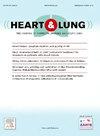无创内皮功能指数在急诊科未分化胸痛患者中的预后价值
IF 2.6
4区 医学
Q2 CARDIAC & CARDIOVASCULAR SYSTEMS
引用次数: 0
摘要
背景:对胸痛(CP)患者的心血管风险进行分层有时是困难的。一种简单的预测这些患者预后的方法可能会有所帮助。该研究的目的是利用内皮外周动脉血压计(Endo-PAT)确定内皮功能评估的预后表现。方法本研究是2016年3月至2017年9月在急诊科(ED)进行的一项前瞻性研究,包括因非创伤性CP就诊的患者。所有患者均使用Endo-PAT装置通过反应性充血指数(RHI)评估外周内皮功能。RHI <;1.19鉴定内皮功能障碍。在一个月的时间里,通过电话随访患者的主要不良心血管事件(MACE)。RHI的预后表现由受试者工作特征(ROC)曲线下面积决定。结果我们研究了503例非创伤性CP患者,在1个月的随访中,4.6%的患者发生了MACE。与未发生MACE的患者相比,这些患者的RHI较低(1.24 [IQR: 1.14-1.38] vs 1.50 [IQR: 1.24 - 1.85], p = 0.04)。随访30天,与TIMI风险评分相关的RHI的ROC曲线下面积为0.74。RHI最佳截止点预测MACE的敏感性为35%,特异性为83%,阳性预测值为9%,阴性预测值为96%。在TIMI评分中加入RHI可提高敏感性和阴性预测值。结论与TIMI评分相结合,RHI检测是未分化CP患者良好的预后工具。本文章由计算机程序翻译,如有差异,请以英文原文为准。
Prognostic value of non-invasive endothelial function index in emergency department patients with undifferentiated chest pain
Background
Stratifying the cardiovascular risk for patients consulting for chest pain (CP) is sometimes difficult. An easy method to predict the prognosis in these patients could be helpful.The aim of the study was to determine the prognostic performance of endothelial function assessment using endothelial peripheral arterial tonometry (Endo-PAT).
Methods
This was a prospective study conducted in emergency departments (ED) from March 2016 to September 2017, including patients presenting to the ED for non-traumatic CP. All patients underwent assessment of peripheral endothelial function, by reactive hyperemia index (RHI), using Endo-PAT device. RHI <1.19 identified endothelial dysfunction. Patients were followed by telephone contact, during one month, for major adverse cardiovascular events (MACE). The prognostic performance of RHI was determined by the area under Receiver Operating Characteristic (ROC) curve.
Results
We studied 503 patients with non-traumatic CP. During 1-month follow up, 4.6 % patients had developed MACE. These patients had lower RHI compared to those without MACE (1.24 [IQR: 1.14–1.38] vs 1.50 [IQR: 1.24–1.85], p = 0.04). Area under the ROC Curve at 30-day follow-up was 0.74 for RHI associated to TIMI risk score. The sensitivity, the specificity, the positive and negative predictive value for prediction of MACE at the best cut-off of RHI were 35 %, 83 %, 9 % and 96 % respectively. The addition of RHI to TIMI score improves the sensitivity and negative predictive value.
Conclusion
Combined to TIMI score, RHI testing is a good prognostic tool in patients with undifferentiated CP.
求助全文
通过发布文献求助,成功后即可免费获取论文全文。
去求助
来源期刊

Heart & Lung
医学-呼吸系统
CiteScore
4.60
自引率
3.60%
发文量
184
审稿时长
35 days
期刊介绍:
Heart & Lung: The Journal of Cardiopulmonary and Acute Care, the official publication of The American Association of Heart Failure Nurses, presents original, peer-reviewed articles on techniques, advances, investigations, and observations related to the care of patients with acute and critical illness and patients with chronic cardiac or pulmonary disorders.
The Journal''s acute care articles focus on the care of hospitalized patients, including those in the critical and acute care settings. Because most patients who are hospitalized in acute and critical care settings have chronic conditions, we are also interested in the chronically critically ill, the care of patients with chronic cardiopulmonary disorders, their rehabilitation, and disease prevention. The Journal''s heart failure articles focus on all aspects of the care of patients with this condition. Manuscripts that are relevant to populations across the human lifespan are welcome.
 求助内容:
求助内容: 应助结果提醒方式:
应助结果提醒方式:


